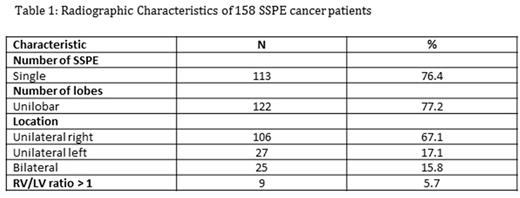Abstract
Background: Acute pulmonary embolism (PE) is a leading cause of morbidity in the cancer population. The availability of computed tomographic (CT) scans and CT-pulmonary angiography (CT-PA) has allowed for better visualization of the peripheral pulmonary arteries and assessment of PE, resulting in greater detection of subsegmental pulmonary embolism (SSPE). The clinical outcomes and the factors determining PE recurrence are not clear in the cancer related-SSPE population.
Our objectives were to evaluate the incidence of recurrent PE within 12 months of SSPE in cancer patients and to identify factors influencing PE recurrence and overall survival (OS).
Methods: A retrospective analysis (2014-2015) of adult cancer patients followed at The University of Texas MD Anderson Cancer Center who were diagnosed with SSPE. The primary outcome was the rate of PE recurrence within 12 months of SSPE diagnosis and to identify clinical and/or radiological factors associated with PE recurrence and overall survival. The study was approved by IRB with consent waiver.
Results: Among 158 patients, 62% were male, 73.9% with stage IV disease, and 58.9% were on chemotherapy at time of SSPE diagnosis. Most of the patients had an ECOG performance status of 0 to1 (74.1%) and had no prior history of venous thromboembolism (VTE) (89.9%). The majority of SSPE (75.3%) were diagnosed incidentally by staging CT versus 24.7% by CT-PA. Amongst clinical factors, active chemotherapy and prior history of VTE at the time of SSPE diagnosis seemed to influence the probability of PE recurrence on the univariate analysis, however there was no statistical significance on logistic regression analysis. The radiological features of SSPE did not impact the rate of PE recurrence (Table 1). A total of 120 patients (75.9%) were treated with anticoagulation alone, 8 patients (5.1%) had IVC filter placement, 14 patients (8.9%) received both anticoagulation and IVC filter, and 16 patients (10.1%) had no therapy. At 12-month follow-up, 15 of 158 patients (9.5%) had PE recurrence. There was no significant effect of anticoagulation in OS, after adjustment for performance status (PS) and tumor stage (TS) (P=0.3971), or by PE recurrence status (P=0.4).
Conclusion: The study showed a clinical significant rate of PE recurrence among cancer patients with SSPE, which is comparable to rates of PE recurrence from data of cancer-specific VTE clinical trials. Specific clinical or radiological predictors for PE recurrence were not identified. The PS and TS were found to be the main predictors of survival in this population, regardless of the secondary prevention strategy used.
Rojas Hernandez: Daichii Sankyo: Research Funding.
Author notes
Asterisk with author names denotes non-ASH members.


This feature is available to Subscribers Only
Sign In or Create an Account Close Modal